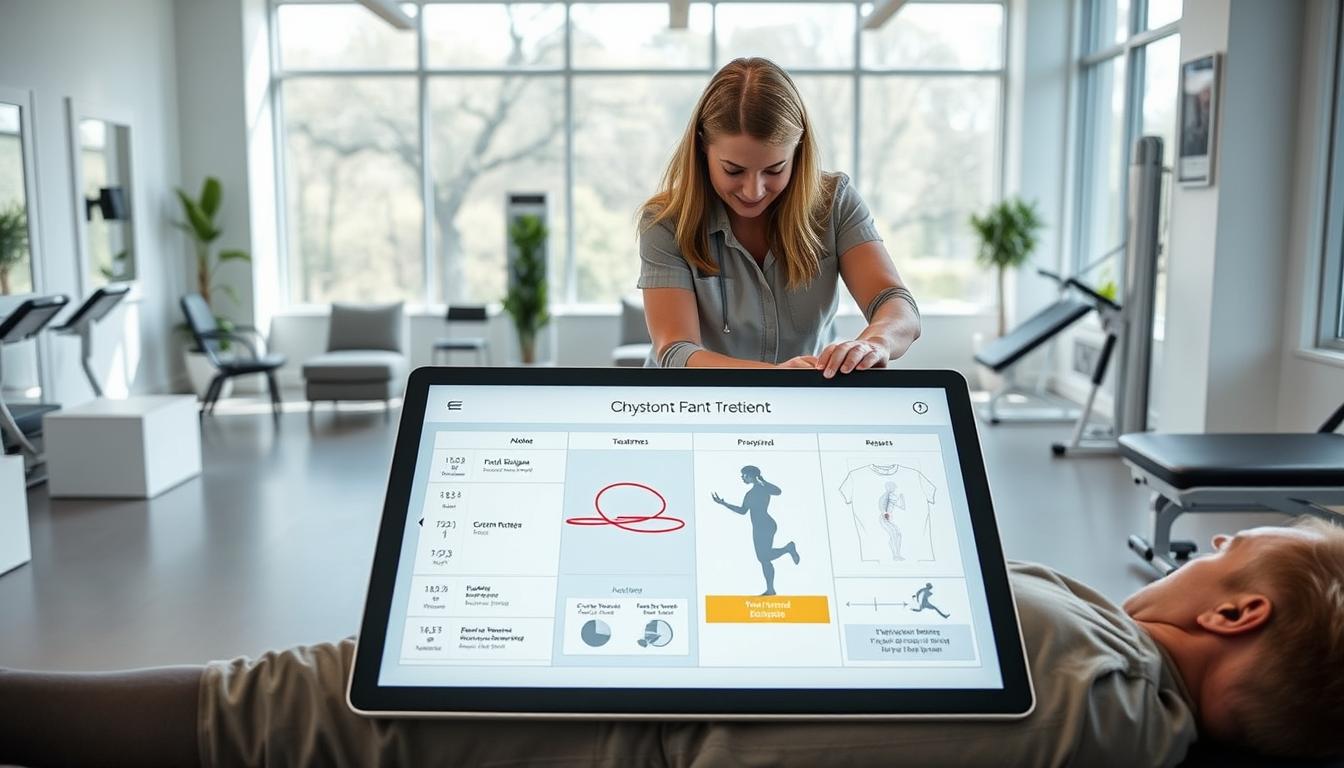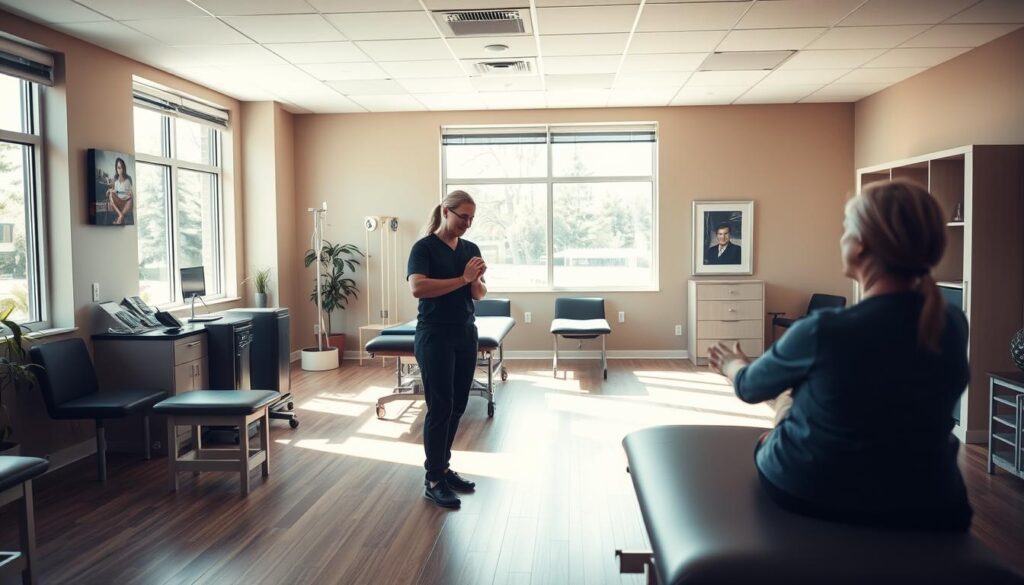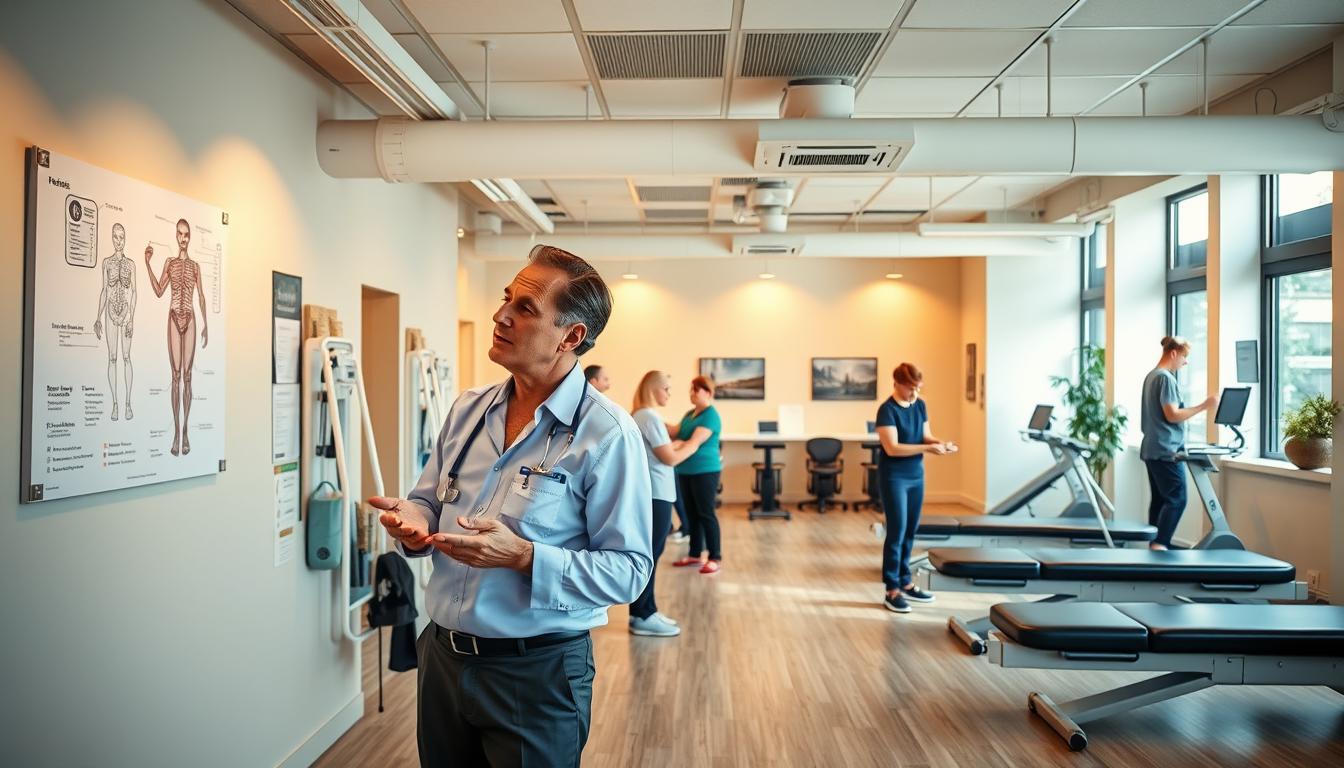Imagine standing at a crossroads of your physical well-being. Every decision you make can either help you recover or hinder your progress. Many of us find ourselves here, dealing with pain, frustration, and the limits of a physical injury.
A personalized physical therapy plan is like a lifeline. It’s made just for you, focusing on your unique needs. This plan considers your current health, lifestyle, goals, and more. It’s all about you and your well-being.
The beauty of a physical therapy customized program is how it changes your rehabilitation journey. You no longer have to follow generic exercises that might not work for you. Studies show 80% of patients leave treatment early due to insurance issues.
With a dedicated therapist, you get one-on-one sessions. This allows for focused attention and better communication. It boosts your chances of a quick and effective recovery.
Understanding Personalized Physical Therapy
Personalized physical therapy is a key approach that focuses on tailored care for each person. It creates a plan that fits your medical history, lifestyle, and goals. Unlike standard treatments, it looks at many factors to make a plan just for you.
What It Means to Be Personalized
A personalized physical therapy plan looks at your posture, muscle tone, and how you move. This helps therapists find what’s holding you back from getting better. It means you get treatments that really help you, not just make the pain go away.
The Difference Between Traditional and Personalized Therapy
Traditional therapy often uses the same plan for everyone. But personalized therapy is all about you. It makes you an active part of your care, which means you’re more likely to stick with it.
This approach also means you don’t waste time on treatments that don’t work. So, you get better faster.
Benefits of a Customized Physical Therapy Program
Getting a tailored rehab plan has many perks. It makes sure therapy meets your specific needs. This leads to better recovery and support for you.
Personalized therapy speeds up healing. It also tackles unique challenges each patient faces.
Enhanced Recovery and Support
A customized physical therapy program boosts recovery rates. Studies show physical therapy helps 72% of people recover. This method uses targeted ice therapy for knee injuries and special spinal alignment for back pain.
These techniques reduce pain and improve joint function. Functional training and dynamic stretching mimic sports. This helps patients get back to their activities faster.
Increased Patient Satisfaction Rates
Patients on a custom plan are happier. About 84% feel pain relief thanks to these programs. They activate tissues and release endorphins.
Regular talks with physical therapists build trust. This makes patients more likely to follow home exercises. Feeling supported and informed boosts their recovery journey.
Therapy sessions last from 90 minutes to 2 hours. Every minute is important. Making sure plans change as needed is key for better recovery and satisfaction.
How to Create Your Personalized Physical Therapy Plan
Your recovery starts with a detailed first meeting. Here, a physical therapist checks your condition. It’s important to talk openly about your goals and any problems you’re facing.
This talk helps create a plan just for you. It makes sure the treatment fits your needs perfectly.
The Initial Consultation Process
In your first meeting, the physical therapist will do a full check-up. They look at your pain, how you move, and your strength. They also check your balance and coordination.
Physical therapists have studied hard for seven years. They know a lot about the body and how to help it. What they learn from you helps make a plan just for you.
Setting Specific Goals for Rehabilitation
After checking you out, they set goals for you. These goals are clear, measurable, and achievable. They might be about less pain, moving better, or getting stronger.
Your plan will change as you get better. They keep an eye on how you’re doing. This makes sure the treatment keeps working for you.
Components of an Individualized Rehabilitation Regimen
An effective rehabilitation plan has key parts that help patients get better and achieve better results. First, a detailed check-up is done to see what the patient can do and what they can’t. This check-up helps doctors create a treatment plan that fits each patient’s needs.
Comprehensive Evaluations
The first step is a detailed check-up. It looks at the patient’s health history, physical state, and daily life. This helps find the right treatments for the patient’s specific needs. Therapists then suggest exercises and changes to help the patient recover best.
Customized Treatment Strategies
Treatment plans are made just for each patient. They might include things like manual therapy, exercises, and learning new skills. The exercises might be for strength, balance, or heart health, depending on what the patient needs. Regular checks and changes are important to make sure the plan is working well.
| Component | Description | Importance |
|---|---|---|
| Comprehensive Evaluations | Initial assessments to gather health metrics and functional capacity. | Sets the foundation for tailored treatment plans. |
| Customized Treatment Strategies | Personalized approaches including exercise and manual therapy. | Addresses unique patient needs to enhance recovery. |
| Regular Monitoring | Ongoing assessments to evaluate progress and adjust plans. | Ensures interventions remain effective and relevant. |
| Patient Engagement | Active involvement of the patient in their rehabilitation process. | Significantly boosts overall success rates. |
Choosing the Right Therapist for Your Needs
Finding the right therapist is key to your physical therapy journey. It’s important to look at their qualifications and experience. A good therapist can tailor care to meet your needs, improving your recovery.
Qualifications and Experience
When searching for a therapist, check their qualifications and experience. Most physical therapists have a Doctor of Physical Therapy (DPT) degree. About 80% specialize in areas like orthopedics or pediatrics.
Choosing a therapist with the right certifications and experience is important. This ensures they can focus on your specific needs.
The Importance of a Good Patient-Therapist Relationship
A strong bond between you and your therapist is vital. Studies show that good communication is key to success. Trust and rapport help you share your concerns and preferences.
Feeling comfortable with your therapist boosts your recovery. It can even lead to a 50% chance of returning to normal activities sooner. Pick a therapist who supports your healing journey.
One-on-One Therapy Sessions: The Key to Success
One-on-one therapy sessions are key for the best recovery and results. They let therapists give you personal attention that meets your needs. They create plans just for you, making sure your therapy fits your goals.
Having your own time with your therapist helps you understand your condition better. It also lets them change your therapy plan as needed.
Benefits of Individual Attention
There are many benefits to one-on-one therapy sessions. These sessions usually last about 60 minutes. This time lets therapists do detailed checks and make exercises just for you.
Many patients see big improvements in just a few sessions. This shows they can recover faster.
- Patients get full attention, which helps them make more progress and avoid setbacks.
- Good relationships between therapists and patients lead to better care.
- Treatment plans made just for you can really help, like improving core stability for back pain.
- Studies show getting individual care can make patients stick to exercise plans 50% more.
- Patients seeing a Doctor of Physical Therapy alone are happier than those in group care.
This model of therapy offers more detailed treatment and lowers injury risk during rehab. The emotional support from your therapist boosts your motivation and confidence. A plan made just for you, with regular changes, makes your physical therapy journey effective and fulfilling.
Monitoring Progress in Your Tailored Exercise Routine
It’s key to track your progress in a tailored exercise routine for the best results in physical therapy. A personalized approach means you’ll need to keep checking how you’re doing. This helps make sure your therapy stays on track with your goals.
Regular checks help see how your body reacts to your treatment plan. This lets you make changes to your program if needed.
Regular Assessments and Adjustments
Your recovery path includes detailed checks on how you move, your strength, flexibility, and balance. These regular checks help your physical therapist see what needs work. This way, your exercise plan can help reduce pain and improve how you move, get stronger, and last longer.
It’s important to keep checking how well you’re doing to adjust your exercises. You might do different things, like stretching, getting stronger, doing cardio, or working on balance.
- Stretching routines
- Strengthening exercises
- Cardiovascular conditioning
- Balance training
Learning the right way to do each exercise is key to getting the most out of them and staying safe. Your physical therapist will help you set goals and keep an eye on your progress. This way, you tackle both symptoms and the root causes of your issues, leading to a full recovery.
People who stick to a personalized workout plan tend to stay motivated. This leads to better results and a more successful recovery. By going for a tailored routine, you can see big improvements in your strength and how well you function.
Techniques in Your Bespoke Treatment Plan
Your treatment plan may include many therapy techniques to help you recover. These methods are key to getting you ready for rehab and keeping you moving forward. By adding bespoke exercises, you can improve your strength, flexibility, and how well you can move.
Therapeutic Exercises
These exercises are made just for you, based on what you need. They help with flexibility, strength, coordination, and balance. Your plan is made after a detailed check-up, so it really fits your situation.
As you get better, your exercises will change to stay effective. These exercises are the base for getting you back to full function and a better life.
Pain Management Strategies
Managing your pain is a big part of your treatment. You might use manual therapy, dry needling, or electrical stimulation to feel better. Each method is designed to lessen pain and help you keep up with rehab.
These strategies are tailored to help you heal faster and stay active. Working with your physical therapist ensures your plan keeps up with your progress.
Integrating Your Personalized Care Plan with Overall Wellness
Combining your care plan with a holistic approach boosts your wellness. This method treats current issues and prevents future problems. It tailors to your health needs, helping you build lasting habits.
Holistic Approaches to Physical Health
Holistic health looks at your whole life, not just symptoms. It includes diet, exercise, stress control, and community support. This way, you gain health knowledge, leading to better results and wellness.
Plans that use holistic methods can cut recovery times by half. They also improve your life quality.
Preventing Future Injuries
Stopping injuries is key for lasting health. Personal care plans teach you how to avoid injuries. They encourage a lifestyle that’s mindful of your body’s needs.
With good planning, you can lower injury chances. This also means fewer hospital visits and less waste in healthcare.
| Benefits of Personalized Care Plans | Statistics |
|---|---|
| Reduction in hospital visits | Evidence suggests significant healthcare cost savings |
| Better compliance and adherence | 70% higher adherence to statin prescriptions |
| Increased likelihood of meeting health goals | 39% increase in achieving systolic blood pressure goals |
| Enhanced quality of life | Approximately 70% report notable pain reduction and improvement |
| Improved patient engagement | High patient engagement correlates with better clinical outcomes |
By linking your care plan with wellness, you get a balanced health approach. This sets the stage for lasting health and injury prevention.
Testimonials from Satisfied Patients
Feedback from patients shows how personalized physical therapy can change lives. Each success story proves the power of customized care plans. People have seen big improvements in their mobility, pain, and daily activities.
Success Stories of Customized Care
Many testimonials share amazing results from tailored therapy. One patient got full shoulder rotation and no pain in just 6 weeks. Another could walk and stand without hip pain after 12 visits, showing the plan’s effectiveness.
The Impact of a Personalized Plan on Quality of Life
Patients often say their quality of life improved with their own rehab programs. A patient with a nerve issue got almost back to normal in 7 months. People praise their therapists, saying they are “incredible,” “highly skilled,” and “empathetic.”
Patients have seen big physical gains, like a 90% pain drop in a few visits. Some even fixed abdominal separation in just five visits. Many wish they had started therapy sooner, highlighting how it cuts down recovery time.
Conclusion
A personalized physical therapy plan is key for the best recovery. It focuses on your unique needs and strengths. Working closely with your therapist sets you up for success.
This plan helps you recover faster and prevents future injuries. It’s a step towards long-term health and wellness.
With a tailored program, you’ll see better mobility, strength, and confidence. This reduces the risk of falls and injuries. Many insurance plans now cover this, making it more accessible.
Your rehabilitation should be as unique as you are. A plan tailored to your goals can greatly improve your results. It helps you regain your independence and quality of life.
Take advantage of personalized therapy to start a healthier future. It’s a chance to improve your life in meaningful ways.
FAQ
What is a personalized physical therapy plan?
A personalized physical therapy plan is made just for you. It’s based on a detailed check-up of your health and how it affects your daily life. This plan includes special exercises and routines to help you get better.
How does personalized physical therapy differ from traditional therapy?
Personalized physical therapy is different because it’s made just for you. It takes into account your health history, lifestyle, and goals. This makes your therapy more personal and effective.
What are the benefits of a customized physical therapy program?
Customized physical therapy can help you recover faster and feel better. It’s tailored to your needs, improving your quality of life and reducing pain.
What should I expect during the initial consultation?
In the first meeting, a physical therapist will check your condition and talk about your goals. This helps create a treatment plan that’s just right for you.
What does a complete evaluation involve?
A complete evaluation looks at your physical abilities and limits. It checks your range of motion, strength, and how well you can function.
How do I choose the right therapist for my personalized physical therapy plan?
Choose a licensed physical therapist with the right training for you. A good relationship with your therapist is key to effective treatment.
Why are one-on-one therapy sessions important?
One-on-one sessions give you focused attention. Your therapist can tailor exercises to meet your specific goals and track your progress.
How is progress monitored in my tailored exercise routine?
Your progress is checked regularly. This lets your therapist adjust your treatment as needed. It keeps your rehabilitation on track.
What types of therapeutic exercises might I encounter?
Your plan might include exercises to improve strength, flexibility, and mobility. It also includes pain management to help with discomfort during therapy.
How can I integrate my personalized care plan with overall wellness?
Integrating your care plan with wellness focuses on your overall health. It includes prevention strategies and teaches you about injury prevention and wellness.
Can you share some success stories from satisfied patients?
Many patients have seen big improvements in mobility and pain after personalized care. These stories show how tailored therapy can change lives for the better.
Source Links
- https://integrativespineandsports.com/5-reasons-why-you-need-personalized-physical-therapy/
- https://bethesdaphysiocare.com/customized-care-the-importance-of-individualized-physical-therapy-plans/
- https://focusforwardwpt.com/2023/03/personalized-physical-therapy-treatment-plans-for-chronic-pain-patients/
- https://bethesdaphysiocare.com/the-importance-of-personalized-treatment-plans-in-physical-therapy/
- https://www.theobstacledoc.com/blog/achieving-fitness-goals-with-personalized-physical-therapy-at-the-obstacle-doc
- https://mtphc.com/the-importance-of-a-personalized-physical-therapy-plan-and-how-it-can-change-your-life/
- https://dallasaccidentandinjuryrehab.com/personalized-rehabilitation-plans-for-sports-injuries/
- https://www.humancareny.com/blog/physical-therapy-home-exercise-program
- https://www.ewmotiontherapy.com/blog/how-physical-therapists-create-treatment-plans
- https://pmc.ncbi.nlm.nih.gov/articles/PMC6687416/
- https://www.bodyworksfargo.com/embracing-personalized-physical-therapy-treating-the-whole-person/
- https://fiziologix.com/blog-fiziologix-physical-therapy-tips-and-self-healing/1/20/2024/what-to-expect-from-a-personalized-rehabilitation-plan-of-care-created-by-a-physical-therapist
- https://www.stjamesrehab.com/blog/the-benefits-of-a-personalized-rehab-plan-for-each-patient
- https://dynamicspinesport.com/blogs/injury/rehabilitation-plan-component/
- https://www.trspinalclinic.com/physical-therapy-tampa/how-to-choose-the-right-physical-therapist-for-your-needs/
- https://www.h2health.com/how-to-choose-the-right-physical-therapist-for-your-needs/
- https://physioprospt.com/3-advantages-of-one-on-one-physical-therapy/
- https://balancedptmi.com/the-benefits-of-one-on-one-physical-therapy-with-a-dpt/
- https://yourlibertypt.com/personalized-care-the-key-to-successful-rehabilitation-and-long-term-health/
- https://focusforwardwpt.com/2024/04/how-your-physical-therapist-can-create-a-proper-exercise-plan/
- https://fritzphysicaltherapy.com/personalized-workout-plans-tailoring-exercises-for-optimal-results/
- https://greenoakspt.com/personalized-training/
- https://tristarpt.com/personalized-physical-therapy-treatment-plans-2/
- https://legacy-physicaltherapy.com/physical-therapy-treatments/physical-therapy/
- https://www.biomotionpt.com/different-physical-therapy-methods/
- https://www.downersgrovehc.com/blog/the-role-of-personalized-care-plans-in-long-term-recovery?372b7fa3_page=7
- https://www.downersgrovehc.com/blog/how-personalized-care-plans-improve-health-outcomes?372b7fa3_page=4
- https://www.chartspan.com/blog/the-role-of-personalized-healthcare/
- https://www.orthorehabpt.com/what-patients-are-saying-about-our-personalized-approach-to-physical-therapy/
- https://www.personalizedphysicaltherapy.org/patient-testimonials
- https://www.decent.com/blog/preventing-falls-and-promoting-independence-the-role-of-personalized-physical-therapy-in-elderly-health
- https://performexpt.com/insights/the-benefits-of-personalized-physical-therapy-for-athletes-and-kids
- https://peakendurancept.com/the-importance-of-individualized-physical-therapy-plans-your-path-to-optimal-recovery/
James Foster, PT is a licensed physical therapist with over 11 years of hands-on experience in helping individuals improve mobility and live pain-free. As a health writer, James shares expert advice, rehabilitation strategies, and wellness tips to empower readers toward healthier, stronger lives.





